Scanner Belt Load and Stretch Compensation Control System
a technology of belt load and stretch compensation, applied in the direction of optical radiation measurement, instruments, ways, etc., can solve problems such as sensor reading errors, and achieve the effect of reducing lead/lag error and loading becoming more uniform
- Summary
- Abstract
- Description
- Claims
- Application Information
AI Technical Summary
Benefits of technology
Problems solved by technology
Method used
Image
Examples
Embodiment Construction
[0035]FIGS. 1A and 2 show a scanner frame system 2 that has upper and lower support beams 4, 6 that are mounted onto a pair of upright end members 8, 10. Associated upper and lower suspended tracks 38 and 44 are secured to the lower surfaces of upper and lower support beams 4 and 6, respectively. In particular, a series of upper individual vertical support structures 120 supports upper track 38 and a series of lower individual vertical support structures 144 supports lower track 44. As described further herein, each track defines a path along which a sensor-mounted roller carriage travels.
[0036]Upper support beam 4 is equipped with a plurality of upper fixed turning pulleys 20, 22 and 24 that are secured to the beam with pins. Each of the upper fixed turning pulleys preferably has a groove around its outer perimeter that is dimensioned to accommodate a flexible belt or cable 32 which is wound around the upper fixed turning pulleys and the proximal end 112 of drive shaft 110. Flexibl...
PUM
 Login to View More
Login to View More Abstract
Description
Claims
Application Information
 Login to View More
Login to View More - R&D
- Intellectual Property
- Life Sciences
- Materials
- Tech Scout
- Unparalleled Data Quality
- Higher Quality Content
- 60% Fewer Hallucinations
Browse by: Latest US Patents, China's latest patents, Technical Efficacy Thesaurus, Application Domain, Technology Topic, Popular Technical Reports.
© 2025 PatSnap. All rights reserved.Legal|Privacy policy|Modern Slavery Act Transparency Statement|Sitemap|About US| Contact US: help@patsnap.com



